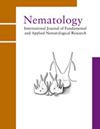Ditylenchus dactylonae n. sp. (Tylenchomorpha: Anguinidae), an associate of Cynodon dactylon (L.) Pers. in the USA
IF 1.2
4区 生物学
Q2 ZOOLOGY
引用次数: 0
Abstract
A new species of the genus Ditylenchus was recovered from rhizosphere soil of a ‘TifEagle’ hybrid bermudagrass (Cynodon dactylon (L.) Pers. × C. transvaalensis (Burtt-Davy)) putting green located at the Pee Dee Research & Education Center, Clemson University, Florence, SC, USA. It is described herein as Ditylenchus dactylonae n. sp. and is characterised by possessing the combined characters of a medium body size (682-815 μm in females; 618-718 μm in males), six incisures at the lateral fields, a delicate stylet (7.6-8.0 μm) with rounded knobs, a bottle-shaped basal pharyngeal bulb (BPB), an excretory pore (EP) near anterior end of BPB, a posteriorly located vulva (V = 78-83%), a reflexed ovary, a uterus with crustaformeria anteriorly and nearly spherical structure posteriorly, a post-vulval uterine sac (30-50% of the vulva-anus distance), an elongate conoid and ventrally bent tail, a tylenchoid spicule (17-18 μm), and a leptoderan bursa. Ditylenchus dactylonae n. sp. was differentiated from other sequenced species by the partial small subunit (SSU) rRNA gene, D2-D3 expansion segments of the large subunit (LSU) rRNA gene and internal transcribed spacer (ITS) rRNA. Phylogenetic analysis revealed that D. dactylonae n. sp. belongs to the D. dipsaci-group, and is sister to D. medicaginis and/or D. ferepolitor based on SSU 18S, LSU D2-D3 and ITS sequences.在美国南卡罗来纳州佛罗伦萨克莱姆森大学Pee Dee研究与教育中心,从一种“TifEagle”杂交狗牙根(Cynodon dactylon(L.)Pers.×C.transvalensis(Burtt Davy))的根际土壤中发现了一个Ditylenchus属的新种。本文将其描述为Ditylenchus dactylonae n.sp.,其特征是具有中等体型(雌性682-815μm;雄性618-718μm)、侧野六个切迹、带圆形旋钮的精致探针(7.6-8.0μm),一个位于后方的外阴(V=78-83%),一个反折的卵巢,一个前部有硬壳的子宫,后部有近球形结构,一个外阴后子宫囊(外阴-肛门距离的30-50%),一条细长的圆锥形和腹部弯曲的尾巴,一个舌形针状物(17-18μm)和一个钩端囊。通过部分小亚基(SSU)rRNA基因、大亚基(LSU)rNA基因的D2-D3扩增片段和内部转录间隔区(ITS)rRNA,将Ditylenchus dactylonae n.sp.与其他测序物种区分开来。系统发育分析表明,根据SSU 18S、LSU D2-D3和ITS序列,D.dactylonae n.sp.属于双囊D.dipsaci类群,是D.medicaginis和/或D.ferepolitor的姐妹。
本文章由计算机程序翻译,如有差异,请以英文原文为准。
求助全文
约1分钟内获得全文
求助全文
来源期刊

Nematology
生物-动物学
CiteScore
2.60
自引率
33.30%
发文量
67
审稿时长
3 months
期刊介绍:
Nematology is an international journal for the publication of all aspects of nematological research (with the exception of vertebrate parasitology), from molecular biology to field studies. Papers on nematode parasites of arthropods, and on soil free-living nematodes, and on interactions of these and other organisms, are particularly welcome. Research on fresh water and marine nematodes is also considered when the observations are of more general interest.
Nematology publishes full research papers, short communications, Forum articles (which permit an author to express a view on current or fundamental subjects), perspectives on nematology, and reviews of books and other media.
 求助内容:
求助内容: 应助结果提醒方式:
应助结果提醒方式:


